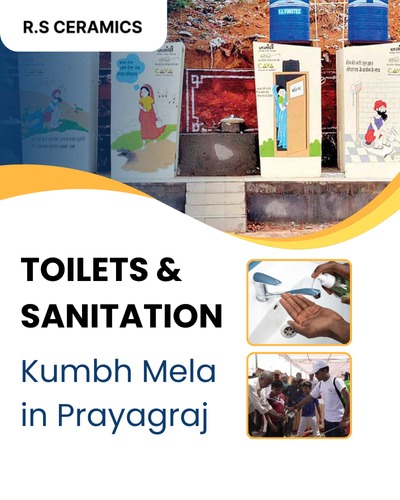Sanitation facilities, including toilets, are among the primary preparation aspects. Millions of pilgrims come there during the Mela; therefore, a huge, effective, and hygienic system of sanitation facilities is necessary on behalf of the authorities. The most crucial amenities that can be offered for public health, hygiene, and comfort of visitors in millions of devotees, as in the case of the Kumbh Mela, are its washrooms.
Sanitation Facilities: Kumbh Mela Washroom Things in Prayagraj
1. Planning and Preparation of Toilets/Shower Room
Planning commences months in advance so that commoners have complete access to proper toilets during Kumbh Mela Washroom Things in Prayagraj. The Government and Municipal authorities, city planners, sanitation experts, and other organizations combine hands to ensure that there are enough numbers, accessible, and hygienic toilets, and shower rooms available for the crowd. Authorities would do a detailed survey of the crowd present at the event to establish movement patterns and busy traffic points to estimate how many washrooms should be erected all over this area.
These toilets are installed all over the campus so that no one would have to go too far. In very densely populated areas like bathing ghats, food stalls, and camping grounds, toilet facilities are considered indispensable. While doing so, overcrowding could be avoided and even high usage toilets could be kept clean.
2. Types of Toilets Offered
Different kinds of restroom facilities are prepared to serve all:
Portable Toilets: The most used facility at Kumbh Mela is the porta toilets. They are highly flexible, can be erected very quickly, compact, movable, and in numbers erecting can be done in minutes. They have an enormous carrying capacity and can be sanitized and emptied in huge numbers.
Water and the environment are saved by using eco-friendly toilets, which reduce the adverse environmental impacts. Most of the eco-friendly toilets are installed using bio-digester technology that breaks organic matter through biological processes. It converts waste into biogas and organic manure.
Community Toilets: Even larger community toilets have more stalls in other areas. Being catering to more people and serving both genders, the capacity is much larger compared to single toilets. Some community toilets have shower facilities and other conveniences to stretch the stay.
Women’s Toilets
In addition to the women’s hygiene needs, more toilets and hygienic and privacy provision facilities are also provided in the women’s toilets. In many toilets, sanitary napkin dispensing and disposal units are also provided for hygiene and comfort.
Sanitation and Sanitary Services
3. Maintenance and Cleaning Arrangements.
Even with such turnover, the maintenance and sanitation of the washrooms do not become any less important. Otherwise, the hygiene problems will not be avoided at all. So, sanitation workers are installed to clean and observe the washrooms at scheduled intervals for 24 hours. This comprises
– Repeat Cleaning: Its high-use areas are cleaned as often as twice within an hour. Some of the nice aspects of its cleaning involve spot-cleaning floors, wiping surfaces, and replenishing toilet paper, and soap, among other essentials. Probably the best thing about cleanliness schedules is that they minimize risks of contamination, then the washrooms are not in use.
– Waste Management: Most proponents of mobile toilets think that it is some form of temporary holding system for waste whereas the waste collection trucks come to evacuate them at times. In such a scenario, environmentally friendly toilets may have bio-digesters or waste-to-energy systems that can digest the waste on-site and minimize or even eliminate the need to manually clean.
-Rapid Repairs Because the size of the event means that the free toilets experience some smaller cracks or breakdowns, maintenance teams plan with rapid repair and rollover works; broken cabins, hand basins, and urinals are all repaired in situ. There mustn’t be queuing in backup toilets from those who need to go to another toilet at altogether different locations on the facilities, and facilities should be used for as long as possible.
. 4. Water and Sanitary Facilities
Clean water supplies should be provided in toilets, where hand washing, and flushing, among numerous other hygiene practices, would be possible; authorities provide and ensure there is enough space for the placement of water tanks with some having elevated systems of gravity feed whereby water will keep on flowing continuously to the toilets and water stations are kept near toilets, prompting hand washing among many other hygiene practices.
All toilets are outdoors, and the hand sanitizer dispensers also stay outside the restroom. Fresh, clean hands are perhaps one of the best barriers against the spread of diseases. Maintenance replenishes soap dispensers, toilet paper, and other hygiene products according to their reserve.
5. Environmental Controls
As the washroom facilities have emerged as the core area of concern for the organizers of the Kumbh Mela, with ecological sustainability in mind, the following measures have been taken to control damage to the environment when millions of visitors are expected there:
Biodegradable liners and materials used in most portable toilets have reduced the usage of plastic and resultant waste.
Bio-Digester Toilets: Toilets are designed specifically with bio-digester toilets that break human excreta into biogas. Meaning that the volume that is transported will decrease. Handling wastes in an environment-friendly manner as it is practiced when bio-digester. toilets are put to use also it will meet the intentions of an eco-friendly event.
– Water Saving Technology: Many of the toilets consist of water-saving flushing mechanisms or a low-flow system. Which uses much less water while maintaining hygiene. This way, the water resources are not too strained because of the large number of pilgrims.
6. Public Awareness and Education
Sanitation at Kumbh Mela needs to be maintained; hence public awareness is to be continued. Sign Boards are found passed along with all the public toilets so that individuals are guided. In the right usage, hand washing, and proper disposal of waste. The governmental department and other organizations conduct campaigns where people visit. The place is urged not to indulge in open defecation and also to use the facility properly.
Volunteers can also be deployed in crowded areas so that the public may be directed. To make proper use of them and make conscious to maintain themselves clean.
Conclusion
The toilets turn into one of the vital and organic elements of Kumbh mela Washroom Things in Prayagraj infrastructure, bringing hygiene, comfort, and public health to millions. At the same time, due to such a massive need, it may be feasible for the governing authorities to choose portable, eco-friendly, and community-based solutions to meet their needs. Such an infrastructure reflects an effort to provide high hygiene and comfort standards for the biggest gathering in the world.


